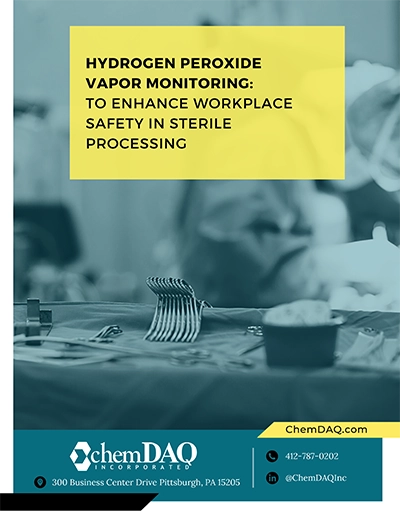Hydrogen Peroxide Vapor Monitoring: To Enhance Workplace Safety In Sterile Processing
LEAKAGE STUDY
Looking to evaluate the impacts of hydrogen peroxide (H₂O₂) sterilization leakage in sterile processing departments, both Advanced Sterilization Products (ASP) and STERIS Corporation conducted independent studies to evaluate H₂O₂ emissions from leading sterilizers used in hospitals around the world.
OVERVIEW
H₂O₂ has become a sterilant of choice for sterile processing departments, as H₂O₂ sterilizers are advertised to offer a much shorter cycle than Ethylene Oxide (EtO). While effective at sterilizing medical equipment used across healthcare, H₂O₂ occupational exposure limits have been established by the National Institute of Occupational Safety and Health (NIOSH), the Occupational Safety and Health Association (OSHA) and the American Conference of Governmental Industrial Hygienists (ACGIH) as vapor leaks can be harmful to workers if exposed.
ASP and STERIS set out to test common sterilizers to determine if emissions were present. The results from both studies were consistent: while chemical sterilizers are built to high standards to minimize gas exposure, toxic vapors can escape from the chamber after a load or during a failure of the operation.
The studies found that residual H₂O₂ vapor concentrations were at their highest inside of the sterilizers at the end of the cycle. Unfortunately, not all of the vaporized H₂O₂ is removed from the chamber at the end of the cycle. Therefore, on opening the sterilizer door and reaching in to remove the processed equipment, workers are potentially exposed to these harmful vapors. The studies consistently recommended that H₂O₂ be continuously monitored to ensure safe and effective use of the sterilization equipment.
CHEMDAQ'S SOLUTION
ChemDAQ, a dynamic chemical monitoring manufacturer based out of Pittsburgh, PA has nearly 20 years of experience monitoring sterilant chemicals, including H₂O₂, EtO and Peracetic Acid (PAA)--three leading sterilant chemicals found throughout healthcare.
All ChemDAQ monitoring systems feature sensor technology that is designed to detect and measure small concentrations of sterilant gas vapors in real-time to alert workers if and when exposure may be imminent.
IMPLEMENTATION
Implementation of a ChemDAQ monitoring system is simple and effective. Oftentimes, monitoring systems are installed immediately above each sterilizer, with the sensor placed as close to the gas source as possible for accurate and reliable readings. Portable solutions are also available to allow sterile processing operators to test for potential gas leaks around sterilizers or determine hot spots that may be caused from poor ventilation.
RESULTS
The implementation of a ChemDAQ monitoring system allows hospital sterile processing departments to enhance onsite safety operations and ensure the continuation of sterilization operations to keep this major hospital function up-and-running.
Product Overview
ChemDAQ monitoring technology is trusted by more than 600 customers across the globe. Read on to learn more about available chemical monitoring solutions.
STERI-TRAC® 2
ChemDAQ's Steri-Trac 2 area monitor can be installed as a fixed monitor in key locations throughout your sterile processing department, providing both visual and audible alerts and the ability to track readings over time and export exposure data for subsequent analysis. The Steri-Trac 2 canalso connect to air handling systems to control both ventilation and air extraction based on H₂O₂ exposure levels.
SAFECIDE™ 2.0
ChemDAQ's SafeCide 2.0 is a portable vapor monitoring system that can be used to identify hot spots or leaks around your sterilizer. Available in both a handheld or tablet format, the device provides accurate, real-time measurements of H₂O₂ or PAA in parts per million (ppm) and offers both a real-time sampling mode and an industrial hygiene mode for time weighted averages (TWA).
WHAT IS HYDROGEN PEROXIDE?
Hydrogen Peroxide is a sterilant chemical used in hospitals and aseptic filling lines in food processing. The concentrations used for sterilization are much higher than the H₂O₂ in the brown bottle commonly found in drugstores (50% + vs. 3%). At high concentrations, it is very effective for killing all forms of microbial life.
While it’s most effective at these high concentration levels, H₂O₂ can produce a colorless, odorless vapor that is hazardous with acute exposure. Exposure to H₂O₂ can occur from inhalation or direct contact, and exceeding exposure limits can often cause irritation to the skin, eyes, nose and throat, as well as headaches, dizziness and nausea/vomiting.
Find Your Safety Solution
ChemDAQ has been an industry leader in chemical monitoring for nearly 20 years. Our team of safety experts stands ready to offer a free safety assessment to identify the best technology based on your needs.

